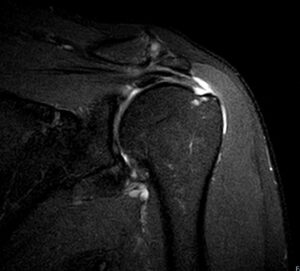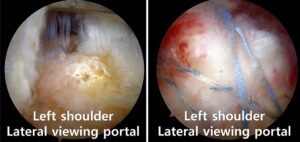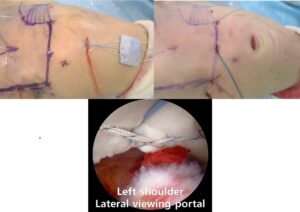Jae-Wook Jung1, Joong-Bae Seo1, Jae-Sung Yoo1*
1Department of Orthopaedic Surgery, Dankook University College of Medicine, Cheonan, Korea
*Correspondence author: Jae-Sung Yoo, MD, Department of Orthopaedic Surgery, Dankook University College of Medicine, Manghyangro 201, Dongnam-gu, Cheonan, Chungnam 330-715, Rep. of Korea, Cheonan, Korea;
Email: [email protected]
Published Date: 30-09-2024
Copyright© 2024 by Jung JW, et al. All rights reserved. This is an open access article distributed under the terms of the Creative Commons Attribution License, which permits unrestricted use, distribution, and reproduction in any medium, provided the original author and source are credited.
Abstract
In paraplegic patients, rotator cuff tears are known to be common. Even after rotator cuff repair, the frequent use of crutches or wheelchairs can lead to high stress on the shoulder, increasing the risk of re-tear. This risk is particularly high in athletes using wheelchairs due to the intense usage. Recently, various tension-free interposition graft methods have been introduced to prevent bone-to-bone contact after rotator cuff surgery. Among these, bursal acromial reconstruction using allodermal matrix grafts is noteworthy because the graft is positioned under the acromion, potentially reducing stress on the glenohumeral joint during crutch use. Thus, the authors aim to review the outcomes of rotator cuff repair and bursal acromial reconstruction in a 47-year-old female paraplegic wheelchair basketball player, alongside a literature review.
Keywords: Shoulder, Rotator Cuff Tear; Reconstruction; Paraplegia
Introduction
Paraplegic patients who use wheelchairs or crutches for extended periods often experience significant weight-bearing stress on their shoulders [1]. Due to the structure of the glenohumeral joint, stability relies not only on bony structures but also on the rotator cuff, which plays a crucial role. As a result, the prevalence of rotator cuff disorders is increasing among paraplegic patients [2]. Previous study have shown that the prevalence of rotator cuff tears is significantly higher in paraplegic patients (63%) compared to the general population (15%) [3]. However, only 10% of paraplegic patients underwent surgical treatment due to concerns about limitations in daily life activities after surgery [4]. Another study found that despite the challenging decision to undergo surgical treatment, rotator cuff repair and prohibiting weight-bearing for 10-12 weeks post-surgery, there was still a notable re-tear rate of 25% [5].
Wheelchair basketball is a popular disability sport with around 30,000 players worldwide affiliated with the International Wheelchair Basketball Federation. It can lead to shoulder joint overload, increasing the risk of rotator cuff injuries [6]. In the study by Curtis, et al., 89% of the 46 wheelchair female basketball players reported shoulder pain and 33 women complained of shoulder pain after starting wheelchair use [7]. In wheelchair basketball players, rotator cuff repair requires extra attention to ensure a successful return to athletic activity, as re-tear and subsequent collision between the humerus and acromion can lead to a recurrence of shoulder pain. The authors believe that bursal acromion reconstruction, which does not bear the load of the glenohumeral joint and is not subjected to tension, is a suitable method for wheelchair basketball players. They intend to report the clinical results along with a literature review.
Case Report
A 47-year-old female wheelchair basketball player presented to our hospital with persistent left shoulder pain lasting for approximately 2 years. Her Visual Analog Scale (VAS) pain score was 8 and she reported shoulder pain that had not improved despite multiple steroid injections, having already been diagnosed with a rotator cuff tear at another hospital. Both the impingement sign and empty can sign were positive, while her range of motion was normal; however, she complained of decreased performance due to pain. Preoperative magnetic resonance imaging showed a full-thickness supraspinatus tear, while no injury to the subscapularis or posterior cuff was observed (Fig. 1).
The patient was also concerned about the approximately 3-month rehabilitation period following rotator cuff repair and had a reluctance towards surgery due to awareness of the high risk of re-tear. After thorough consultation with the patient, the authors believed that a tension-free interposition graft using allodermis would be suitable. Among various techniques, they thought that bursal acromion reconstruction would be the most appropriate method, as it does not affect the weight-bearing stress on the glenohumeral joint.
Surgical Procedure
The surgery was performed under a brachial plexus block without general anesthesia and was conducted in the beach chair position. A single triple-loaded suture anchor (Y-Knot® RC Anchor, ConMed, New York, USA) and two lateral knotless anchors (PopLock, ConMed, New York, USA) were used to perform a suture bridge repair (Fig. 2).
To perform bursal acromion reconstruction after rotator cuff repair, acromioplasty was conducted to prepare the bone bed. After measuring the acromion undersurface, a 30 mm x 20 mm, 4 mm thick acellular human dermal allograft (Megaderm, L&C BIO, Seoul, South Korea) was placed on the acromion undersurface using a shuttle relay through the anteromedial portal, Neviaser portal and posteromedial portal with a spinal needle. Fiberwires tied at each corner were passed through the subcutaneous layer above the acromion and secured with knots (Fig. 3,4).
Post-operative Rehabilitation and Follow-up
An abduction brace was used for 6 weeks postoperatively. Pendulum exercises were started 1 week after surgery, passive range of motion exercises from 3 weeks, assisted active range of motion exercises from 6 weeks and active exercises from 12 weeks post-surgery. Active weight-bearing activities such as using crutches were prohibited and electric wheelchairs were used for 12 weeks.
Rehabilitation and practice games for competition were allowed from 6 months postoperatively and the patient returned to formal competition at 9 months post-surgery. At 12 months postoperatively, the ultrasound examination did not show any signs of rotator cuff re-tear or graft failure. The Visual Analog Scale pain score was 0, indicating improvement in shoulder discomfort experienced during games. The Constant shoulder score was 98 and the American Shoulder and Elbow Score was 90, reflecting satisfactory results.

Figure 1: A full-thickness supraspinatus tear was observed on the preoperative magnetic resonance imaging.

Figure 2: (A) A full-thickness supraspinatus tear was observed on the arthroscopic finding. (B) A suture bridge repair was performed for the supraspinatus tear using one medial anchor and two lateral anchors.

Figure 3: (A) The allodermis graft at the medial corner was passed through the three medial portals using fibers through the lateral portal. (B) The fibers that passed medially were then threaded back laterally through the subcutaneous layer and tied securely. (C) The proper placement and tension of the graft were confirmed via the scope.

Figure 4: Postoperative magnetic resonance imaging showed the interposition graft firmly positioned on the acromion undersurface.
Discussion
Rotator cuff tears are quite common in patients with paraplegia, but they are controversial due to the high rate of re-tear even after surgery. Recent studies have reported good short-term outcomes following rotator cuff repair surgery, including pain relief, functional improvement and increased muscle strength. However, in the medium to long term, re-tearing and recurrence of symptoms are frequent [5,8]. In patients with paraplegia, a longer recovery period is often needed to prevent re-tearing, making rotator cuff repair surgery a particularly challenging decision for wheelchair basketball players who hope to return to their sport quickly. Additionally, research indicating the potential for long-term recurrence of pain after surgery adds to the difficulty of choosing surgical treatment.
In paraplegic patients, most rotator cuff tears involve the supraspinatus. Mall, et al., reported that 84% of the cases involved supraspinatus tears, 39% involved infraspinatus tears and 78% involved subscapularis tears [9]. This is closely related to the vertical stress placed on the shoulder joint due to weight-bearing through the upper body. Akbar, et al., reported a high rate of supraspinatus tears, with 61% in 100 paraplegic patients compared to 14% in the control group [3]. Therefore, it is essential to consider methods to reduce the vertical stress on the shoulder in paraplegic patients.
Recently, various augmentation methods have been reported to reduce re-tear rates following rotator cuff repair surgery [10-12]. Among these, tension-free interposition grafts show lower failure rates due to the absence of tension. The authors believe that bursal acromion reconstruction, which is unaffected by axial stress on the glenohumeral joint, is a suitable augmentation method for paraplegic patients. In 2022, Berthold, et al., reported through a biomechanical cadaveric study that bursal acromion reconstruction significantly improved the maximum abduction angle, glenohumeral superior translation and subacromial peak contact pressure [12]. Therefore, since bursal acromion reconstruction has the effect of reducing axial forces on the glenohumeral joint, it can be expected to help prevent re-tearing after rotator cuff repair.
Mirzayan, et al., found that after superior capsular reconstruction, when graft tears occurred on the glenoid side and the dermal graft remained positioned between the humerus and acromion, the outcomes were similar to those with successful healing [13]. In contrast, when tears occurred on the humeral side and bone-to-bone contact between the humerus and acromion occurred, the results were not favorable. In 2024, Seo, et al., reported a 0% graft failure rate following the use of tension-free interposition grafts, specifically bursal acromion reconstruction [10]. They also observed improvements in pain and function without the need for supraspinatus repair. Therefore, the authors concluded that in wheelchair basketball players, even if the supraspinatus re-tears, the allodermal matrix fixed to the undersurface of the acromion will remain continuously positioned between the humerus and acromion. This suggests a high likelihood of maintaining improved function without pain or functional decline due to bone-to-bone contact.
Conclusion
To assign statistical significance to the outcomes of rotator cuff repair and bursal acromion reconstruction in wheelchair basketball players or paraplegic patients who bear weight through their upper body, additional studies with larger case numbers are needed. The authors aim to report on a 47-year-old female wheelchair basketball player who, after undergoing rotator cuff repair and bursal acromion reconstruction, showed improved pain and clinical function without cuff re-tear, along with a review of the literature.
Conflict of Interest
The author declares that he has no conflict of interest in this paper.
Ethical Statement
This study was reviewed and accepted by the Dankook University medical center Institutional Review Board.
Ethics Approval and Consent to Participate
This article does not contain any studies with human participants or animals performed by any of the authors. This study was reviewed and accepted by the Dankook University medical center Institutional Review Board.
Consent for Publication
The authors declare that they have no conflict of interest.
Availability of Data and Material
It is available when reviewers request.
Funding
There is no funding source.
Authors’ Contributions
J.B.S and J.S. Y. designed this study, J.S.Y and J.W.J. took the radiologic measurements and gathered the retrospective data.
References
- Hastings J, Goldstein B. Paraplegia and the shoulder. Phys Med Rehabil Clin N Am. 2004;15(3):699-718.
- Curtis KA, Drysdale GA, Lanza RD, Kolber M, Vitolo RS, West R. Shoulder pain in wheelchair users with tetraplegia and paraplegia. Arch Phys Med Rehabil. 1999;80(4):453-7.
- Akbar M, Balean G, Brunner M. Prevalence of rotator cuff tear in paraplegic patients compared with controls. J Bone Joint Surg Am. 2010;92(1):23-30.
- Pentland WE, Twomey LT. Upper limb function in persons with long term paraplegia and implications for independence: Part I. Paraplegia. 1994;32(4):211-8.
- Oh JH, Kim W, Kim JY, Rhee YG. Outcomes of rotator cuff repair in patients with comorbid disability in the extremities. Clin Orthop Surg. 2017;9(1):77-82.
- Yildirim NU, Buyukozturk S, Bayramlar K, Ozengin N, Kulunkoglu BA, Coban O. Developing a shoulder pain scale for wheelchair basketball players. J Back Musculoskelet Rehabil. 2019;32(3):479-85.
- Curtis KA, Black K. Shoulder pain in female wheelchair basketball players. J Orthop Sports Phys Ther. 1999;29(4):225-31.
- Valiquette AM, Graf AR, Mickschl DJ, Zganjar AJ, Grindel SI. Rotator cuff repair in upper extremity ambulators: an assessment of longitudinal outcomes. JSES Int. 2022;6(6):942-7.
- Mall NA, Lee AS, Chahal J. An evidenced-based examination of the epidemiology and outcomes of traumatic rotator cuff tears. Arthroscopy. 2013;29(2):366-76.
- Seo JB, Jung JW, Yoo JS. Combination of arthroscopic biologic tuberoplasty and bursal acromial reconstruction. J Orthop. 2024;51:1-6.
- Seo JB, Kwak KY, Park B, Yoo JS. Anterior cable reconstruction using the proximal biceps tendon for reinforcement of arthroscopic rotator cuff repair prevent retear and increase acromiohumeral distance. J Orthop. 2021;23:246-9.
- Berthold DP, Ravenscroft M, Bell R. Bursal Acromial Reconstruction (BAR) using an acellular dermal allograft for massive, irreparable posterosuperior rotator cuff tears: a dynamic biomechanical investigation. Arthroscopy. 2022;38(2):297306.
- Mirzayan R, Stone MA, Batech M, Acevedo DC, Singh A. Failed dermal allograft procedures for irreparable rotator cuff tears can still improve pain and function: The “Biologic Tuberoplasty Effect”. Orthop J Sports Med. 2019;7(8):2325967119863432.
Article Type
Case Report
Publication History
Accepted Date: 03-09-2024
Accepted Date: 23-09-2024
Published Date: 30-09-2024
Copyright© 2024 by Jung JW, et al. All rights reserved. This is an open access article distributed under the terms of the Creative Commons Attribution License, which permits unrestricted use, distribution, and reproduction in any medium, provided the original author and source are credited.
Citation: Jung JW, et al. Arthroscopic Bursal Acromial Reconstruction for Paraplegic Basketball Player: A Case Report. J Ortho Sci Res. 2024;5(3):1-6.

Figure 1: A full-thickness supraspinatus tear was observed on the preoperative magnetic resonance imaging.

Figure 2: (A) A full-thickness supraspinatus tear was observed on the arthroscopic finding. (B) A suture bridge repair was performed for the supraspinatus tear using one medial anchor and two lateral anchors.

Figure 3: (A) The allodermis graft at the medial corner was passed through the three medial portals using fibers through the lateral portal. (B) The fibers that passed medially were then threaded back laterally through the subcutaneous layer and tied securely. (C) The proper placement and tension of the graft were confirmed via the scope.

Figure 4: Postoperative magnetic resonance imaging showed the interposition graft firmly positioned on the acromion undersurface.


